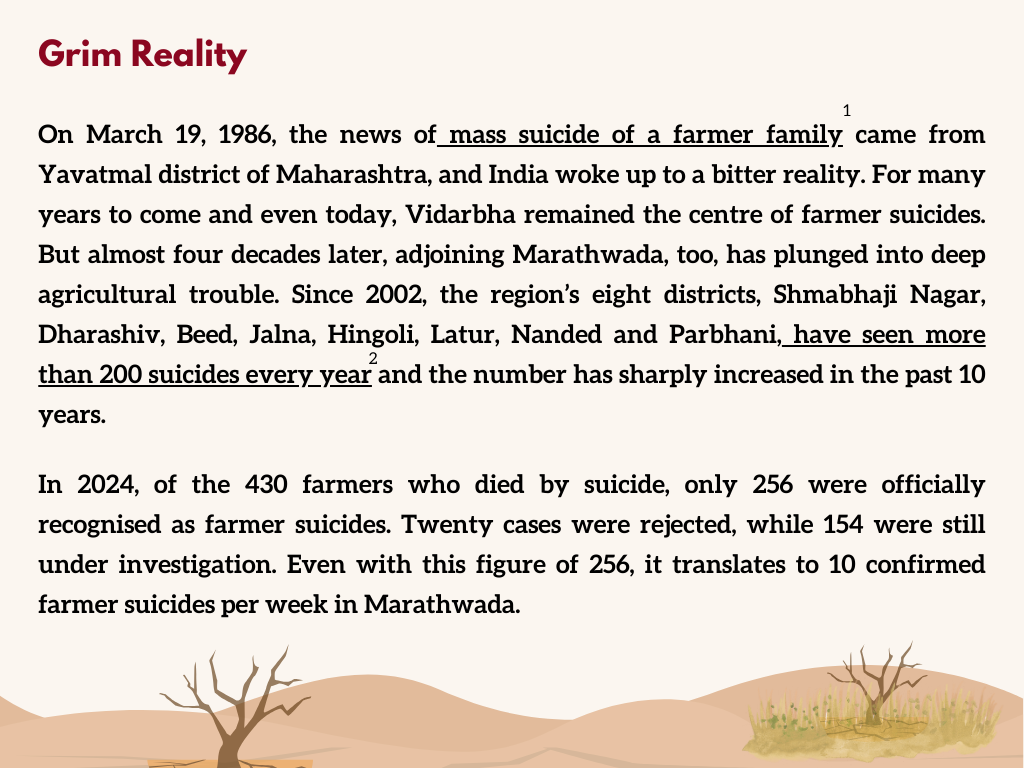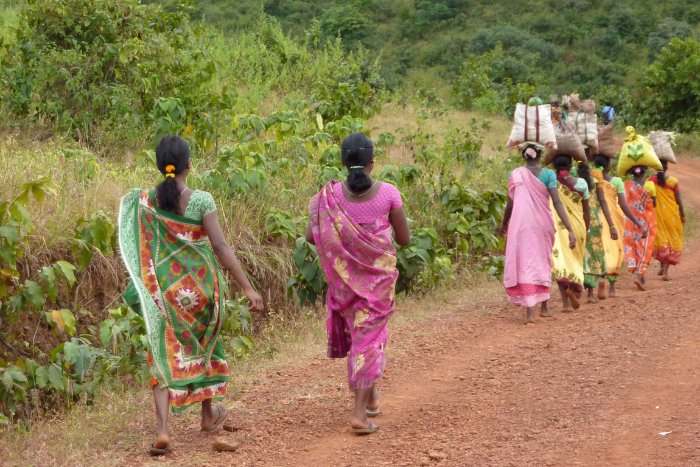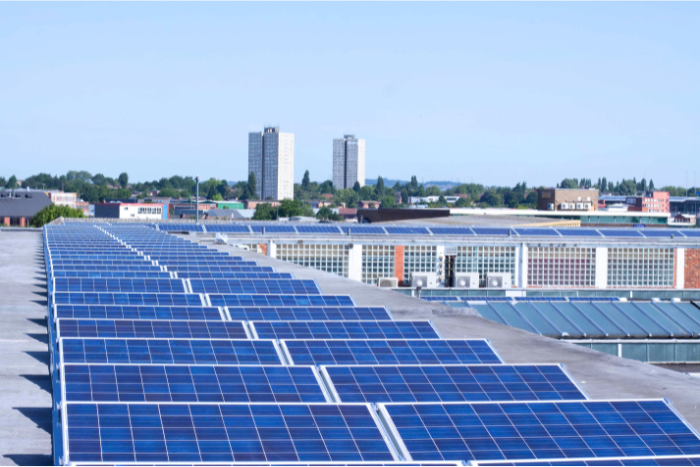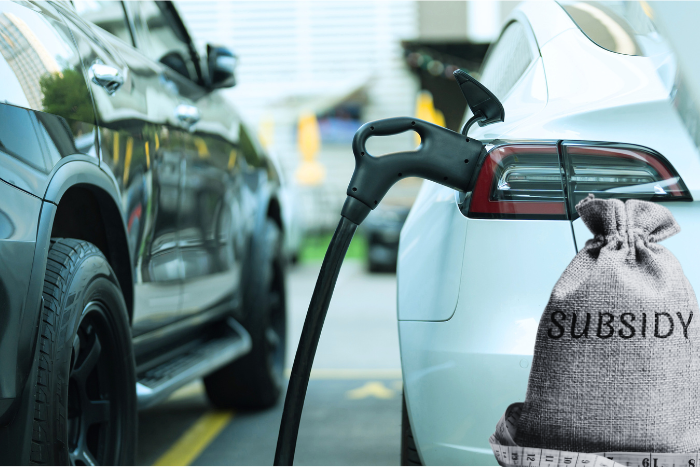


Marathwada’s agrarian crisis, driven by climate change, economic struggles, and unsustainable farming, has caused widespread farmer suicides, but some women farmers are offering a glimmer of hope by adopting sustainable practices for survival Read more
Despite some government interventions, such as fertiliser subsidies, the situation continues to deteriorate due to the unpredictability of weather patterns caused by climate change, including erratic rainfall and extreme weather events.
Rain and ruin: How climate extremes are fueling Marathwada’s agrarian crisis
Marathwada’s agrarian crisis, driven by climate change, economic struggles, and unsustainable farming, has caused widespread farmer suicides, but some women farmers are offering a glimmer of hope by adopting sustainable practices for survival
In Pimpalgaon village of Beed district, Archana Mahadev, 30, looks at her cotton fields spread across almost two acres, with a mix of hope and trepidation. Harvest time is imminent but she is more worried about her husband than she is about saving her crops. In the past seven years, two close family members died by suicide because of crop failure and mounting debts.
According to the government data, in the first six month of this year – between January and June – in the eight districts of Marathwada, 430 suicide cases were reported. Beed was at the top of the list with 101 cases.
In the first week of September, at least 10 people died and crops across 12 lakh hectares were destroyed because of heavy rain in Marathwada. Some of the areas its eight districts received more than 130 mm rainfall in 24 hours, which is unusual for a region considered to be dry and drought-prone. It affected more than 14 lakh farmers in 883 districts of Marathwada.
The situation, particularly in Beed district, reflects a deep agrarian crisis, exacerbated by climate change, economic hardships, and unsustainable agricultural practices.
“I am worried about my husband now. Despite being educated, he does not have any job and agriculture is becoming increasingly difficult here. Here the farmers are giving up their lives under distress,” she says.

The story of farmer suicides, which began in Vidarbha, has now expanded into Marathwada, where more than 100 farmers in Beed alone took their lives in the first half of 2024. CarbonCopy travelled across Marathwada and found factors such as reduced landholding, water scarcity, high input costs, lack of crop diversification, and an absence of adequate support systems, such as fair minimum support prices (MSP), have trapped farmers in a cycle of poverty and despair.
Efforts are being made to adopt sustainable farming practices, particularly by women farmers who have taken over the reins after losing male members of their family to suicide. These women are now promoting organic, low-cost, sustainable farming methods that rely on natural fertilisers and diverse crop production. These initiatives offer a glimmer of hope in a region otherwise marked by distress and migration due to agrarian collapse. However, without systemic changes, such as better access to credit, crop insurance reform, and climate-resilient agricultural policies, the cycle of farmer suicides and rural distress may continue.
Brief history of agrarian crisis in Marathwada
Bordering the states of Karnataka and Telangana, Marathwada (also known as Aurangabad Division) is surrounded by Vidarbha, Nasik and Pune divisions of Maharashtra. It is situated in the rain shadow belt of the Ajanta mountain range and prone to drought conditions. The main crops grown in the region are cotton, sugarcane, soybean, turmeric, wheat and pulses.
According to social worker Jayaji Paikrao, 70, who is helping the families of deceased farmers in Hingoli district, the root cause of the distress among farmers over the years is the unsustainable and costly means of agriculture introduced by policy makers in the name of “modern agriculture”.
“In the 1970s with the advent of the green revolution, farmers left the conventional methods and started using the hybrid seeds and chemical fertilisers and pesticides. Our then chief minister Vasantrao Naik was very keen to promote modern agriculture with the advice of agriculturist MS Swaminathan. Initially, it gave good results in terms of high yield of crops, but later farmers became captive of many problems. The hybrid seed demanded more and more water, fertilisers and chemicals and over the years sown area reduced as the land distributed among family members. This increased their cost of production.,” Paikrao said.
He says, “The government encouraged the farmers to grow cash crops like cotton, soybean and sugarcane. Loans were provided to them through banks. But the crop failed, money was used in non-agriculture activities and debt engulfed the life of farmers.”
The situation now continues to deteriorate due to the added unpredictability of weather patterns caused by climate change, including erratic rainfall and extreme weather events.
Climate change, the worsening factor
Climate change is adding another layer in this tale of farm distress. Since high fluctuation of temperature and humidity and unpredictable nature of rain is ruining the crops, it causes more financial distress to farmers.

Dr Ramanjaneyulu GV, executive director, Centre for Sustainable Agriculture working in Maharashtra, Andhra Pradesh and Telangana, says the abnormality in the graph of rainfall, humidity and temperature is sharply increasing and for successful agriculture a very detailed micro picture is needed.
“Unfortunately, the government is just looking at total rainfall in a certain period. It does not look at the distribution of rainfall over the whole season or year. The number of rainy days are coming down and rain on a particular day is increasing. But the gap between the two rainy days is long. So (in the absence of rainfall) any crop may survive for about ten days but not more than that,” Ramanjaneyulu says.
The government admits the impact of climate change on crops and says the scientific inputs are provided to farmers to avoid losses. Dr PP Shelke, senior scientist and head of Krishi Vigyan Kendra, Hingoli, tells us, “We provide farmers knowledge based support. We form farmer’s groups and tell them what to grow and when to grow so that they may combat the unpredictability induced by climate change. But technology also has a limit. If rain is delayed beyond a particular period for a crop, say 10 days, one can’t do anything.”
In such a scenario, Ramanjaneyulu points out problems such as unavailability of bank credit to tenant cultivators. As per rules, only land-owning farmers get the credit facility. But in reality the cultivators are tenants.
Ramanjaneyulu says, “Maharashtra, on paper, does not acknowledge tenancy, but in practice there is a lot of tenancy. Tenant farmers cultivate the land and there is no written tenancy agreement and these people (tenants) do not get loans from banks. They go to private lenders and get trapped in debt as the interest rates are very high.”
To make matters worse, a farmer who dies by suicide is not eligible for compensation if he or she took a loan from private money lender. Another problem is crop insurance rules, which define an administrative block or circle (that has many villages) a unit to define the eligibility of getting the insurance coverage.
“Unless 50% of the crop is not destroyed in a block the farmer of a village in that block isn’t eligible for compensation,” says Dr Ramanjaneyulu. With the increasing vagaries of weather and climate, it would be better for farmers if the deciding unit for compensation is smaller, he adds.
Ajit Nawale, secretary of All India Kisan Sabha, Maharashtra, says, “We are continuously demanding that the unit of crop insurance should be a village. The climatic conditions, even in a village, varies in two different places. How can a bigger unit with 20 or 30 villages together do justice while assessing the damage? But whenever we raise demand for a smaller unit, the government says that it is not viable for the companies to employ staff at this (village) level. Why is the government worried about the companies who earn so much profit from premium?”
Fertilisers and pesticides: Eating profits, adding carbon impact
This high use of pesticides and chemical fertilisers has played a major role in dragging the farmers into debt. According to statistica, the wholesale price index of pesticides jumped from 107.5 in 2013 to 143.4 in 2023, which is a jump of 33% in 10 years.
Maharashtra has the highest use of pesticides in India. According to the data available on the government website, in the year 2021-22, a total of 63,284 tonnes of chemical pesticides were used in the country and Maharashtra used 13,175 tonnes of it — almost 21% of national consumption. According to a report by Pesticide Action Network (PAN), the use of pesticides in Maharashtra has gone up by over 35% between 2014-15 and 2018-19, while the national average growth was around 13% between 2014-15 and 2017-18.
Over the years, the graph of consumption of chemical fertilisers has steadily gone up and this has contributed to degrading the environment and increasing the problem of GHG emissions. According to Fertiliser India, the sale of urea, which is responsible for high emission of (nitrous oxide) N2O — a greenhouse gas 300 times more powerful than CO2 — has gone up by over 12.5% in Maharashtra in eight years — from 2.29 million tonnes in 2012-13 to 2.58 million tonnes in 2023 — an increase of over 12.5% in a decade. Globally, the agriculture sector is responsible for more than 70% emission of nitrous oxide in the atmosphere.
“Use of chemical fertiliser is a problem for the climate and health of soil. Every 100 kg of urea you use, releases 1.2 kg of nitrous oxide. This means around 350 or 400 kg of CO2. So the more urea you use in the fields, more GHG emission happens and the problem of climate change increases,” says Dr Ramanjaneyulu.
“Second with the rising use of urea, the water holding capacity of soil goes down. Earlier, the water holding capacity of soil was high so if there is no rain for 10 days the crop would survive but now because of excessive use of urea the soil pores are covered and no water infiltration. Therefore just a delay of five days in rain can kill the crop because there is no moisture in the soil.”
Degrading soil health —aided by depleting water resources further enhances the crisis.
Depleting water table, declining returns
This dry region has faced frequent drought or below normal rainfall years, particularly since 2011. Because more than 80% of the agricultural land of Marathwada is dependent on rain, it has aggravated the situation in the past 15 years. The water table is fast depleting as the cash crop like sugar cane — which is grown in less than 5% of crop area — consumes two-third of water available for irrigation. This has resulted in depletion of the water table and drying of water bodies.
Suresh Chand, a farmer of Dharashiv tells CarbonCopy, “The water table has fallen up to 700 feet in many places. Some places, farmers have to dig 1,000 feet deep to get water. This adds to the cost of production heavily. Forget the crops, due to lack of water, we cannot grow even the green fodder for our livestock. It makes animal husbandry also impossible for us.”
Researchers of Tata Institute of Social Science (TISS), Tuljapur, campus have calculated the cost of per acre production of soybean — a widely grown cash crop in Marathwada — and found that a farmer has to spend ₹24,613 for the crop grown on one acre and the best quality soil yields 10 to 15 quintal of crop. Average quality soil produces 8-9 quintal and low quality soil gives 5-6 quintal in a season, which takes around four months to grow—from the sowing stage to harvesting the crop.
“If four family members are engaged in the cultivation, even the highest yield of 15 quintals will give them ₹75,000 per acre. When you subtract the expenditure, the income is just ₹50,000 in hand. It means for one acre crop, per person per month earning is just around ₹3,100 only,” one researcher explains to this writer.
It is important to note that the above calculation is for the best case scenario when the soil is most fertile and crop growing conditions are favourable and harvest gets good cost in market. Hanumant Rajgore, a farmer leader and activist, says farmers generally don’t get more than eight quintals of soybean crop from one acre and often they don’t get good prices in the market when they go to sell it.
He says, “Most of the farmers do not have more than 5 acres of land. So the monthly earning, even in the best yield scenario (as per above calculation) is not more than ₹15,500 per person.”
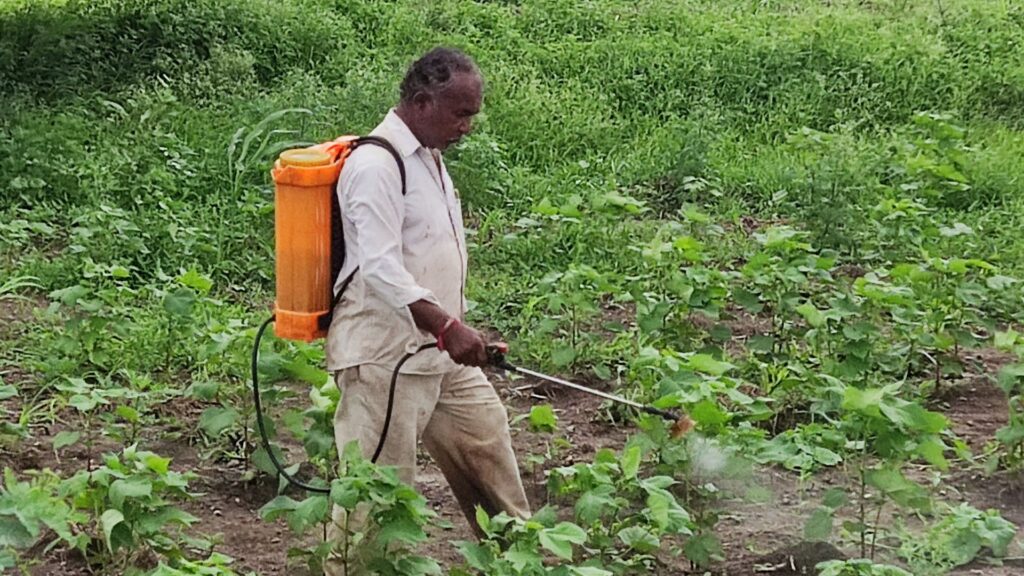
Farmers in many districts of Marathwada also complained that they do not get the minimum support price (MSP) for their crops. Farmers want 50% additional payment on the total input and rent on the land, as per MS Swminathan’s formula (C2+50%) to calculate MSP.
Rajgore says, “MSP is just an announcement by the government. It is not even legally binding for private buyers. So in the open market farmers get ₹500-600 less for every quintel of their crop. Less than 10% of farmers get the benefit of MSP. ”
The lack of reliable measures like MSP also keeps farmers away from taking up diverse crop cultivation.
Low diversification, reduced land holding
A TISS, Tuljapur, report highlights the low diversification in agriculture in the region. It says, “Despite suitability of land and climate to horticulture in the district, the percentage of farmers with any horticultural land is only about 1.8%. This shows low diversification in the farming sector and high dependence on traditional farming.”
But experts say successful diversification needs an assurance of guaranteed price. In the absence of that, farmers choose high commercial cash crops because prices of other traditional crops are stagnant. They take the risk but all high-value crops see high fluctuation we well. When the yield is high, prices fall.
Agriculture expert Devender Sharma says, “We have seen that in a crop like soybean, the farmer got payment up to ₹8,000-9,000 8 per quintal in a year but then they were forced to sell the same crop for less than ₹4,000 per quintal. This fluctuation is fatal for the farmer.”
Government officials accept reduced land holding, high cost of production and low returns have played a role farmer’s suicides in the region.
Khushal Singh Pardeshi, additional collector of Hingoli district says, “Land holding is inversely proportional and the expenditure is directly proportional with the time.” According to him, the “soil potential” has gone down due to use of chemical pesticides and continuous cropping. Therefore the “gap between income and needs of farmers is getting wider.”
“To help the farmers, the government gives subsidies on fertilisers. In Maharashtra, the predominant crop is soybean and the government has a fixed MSP for that. For cotton also we are regulating the price. For other crops, the state is supporting NAFED activities with the help of our state marketing federations, which helps the farmers to get good prices.”
Seema Kulkarni, a social worker who is National Facilitation Team member of Mahila Kisan Adhikar Manch (MAKAAM) Forum for women farmers’ rights, says, “All our surveys and observations on the ground show that poverty and inequality have only deepened in the rural hinterlands. Vidarbha and Marathwada are regions where the agrarian distress is increasing. Suicides are on the rise and so is distress migration. Farmers are not getting the price for the crops they cultivate.”
But all hope is not lost.
Women farmers, fighting back with sustainable means
When the husbands die by suicide, their wives are left with no financial or social security to support themselves or their children.
“Often the family [of deceased farmer] does not give these women any share in whatever property they have. They are exploited by outsiders, money lenders and even by their close relatives,” Paikrao tells Carboncopy.
Anita Jalinder Mane, 34, in Ahirwahe village of Beed district was ousted from family when her husband died by suicide a few years ago. Today, she is fighting back with the help of some volunteer groups.
Minakshi Tokle, a social activist working for the welfare of rural women through sustainable agriculture methods, says, “A better synergy within the family may help. Women generally know what to sow in a particular season and which seed family should preserve for the next crop. We are encouraging active women participation for more sustainable farming.”
In many places in Marathwada, women have pulled themselves together and scripted a story of hope. They have adopted low-cost sustainable ways of farming with home grown fodder and organic manure, saying no to chemical fertilisers and pesticides. With community support they have planned and diversified their crops and sell them at good prices. Paikarao introduced us to several such women in Hingoli district, who have come together to script a story of change.

Kalawati Savandkar, 40, leads a group of 21 women in Tembhurni village where they grow soybean, cotton, turmeric, paddy besides vegetables and pulses.
“We were plunged into debt but now we have learned to defeat the misfortunes. We grow at low cost and get good prices for our crops with the help of a community network. It also keeps the soil and water healthy in this area,” Kalawati says.
Kulkarni says with the collective effort “women are now designing their farms with a diverse mix of food, cash crops, pest management crops- basically a farm that is synergistic.”
“They are moving towards an ecologically sound self-reliant agriculture, saying no to corporate controlled farming, which is chemical intensive and where only commercial crops are grown and sold. This change was possible due to several dialogues with women farmers questioning the present model of agriculture, social structures of discrimination like caste, patriarchy and class,” she says.
.
The letter to the Centre said of the 848 villages “257 villages with 25,007 families have already been relocated since the inception of the Project Tiger.
Conservationists demand withdrawal of relocation of forest dwelling communities
Forest rights and conservationist organisations across India have demanded withdrawal of ‘illegal’ relocation of villagers from tiger reserves which is ordered by the National Tiger Conservation Authority (NTCA), The DTE reported.
The report said that the notification issued on June 19, 2024, identified 89,808 families from 848 villages and directed the authorities to relocate the residents living inside areas notified as core areas of the tiger reserves on a ‘priority basis’ and called for time-bound action plans.
The outlet said the residents were mostly from the Adivasi and other forest-dwelling communities who were entitled to live and use the forest produce for their livelihood as enshrined in the Forest rights Act, 2006 [FRA] as well as The Wildlife (Protection) Act, 1972 [WLPA].
The letter to the Centre said of the 848 villages “257 villages with 25,007 families have already been relocated since the inception of the Project Tiger. Now 591 villages with 64,801 families are remaining inside the notified core.”
Extreme climate events of floods and drought impact 85% of India’s districts: Study
A district-level research has found that around 85% of India’s districts are exposed to extreme climate events while 45% witnessed a “swapping” trend, where flood-prone districts now faced droughts and vice versa, The Indian Express reported.
The study, by IPE Global and Esri India, also mapped the extreme climate events between 1973 and 2023 and found that the frequency, intensity and unpredictability of these climate extremes have increased fourfold, the newspaper report said.
The researchers assessed extreme events using spatial and temporal modelling. The outlet cited the study saying : “More than 60% of districts in Bihar, Andhra Pradesh, Odisha Gujarat, Rajasthan, Uttarakhand, Himachal Pradesh, Maharashtra, Uttar Pradesh, and Assam are witnessing more than one extreme climate event.”
As per the findings, over 90% districts of Assam, 87% in Bihar, 75% in Odisha and 93% in Andhra Pradesh and Telangana were exposed to extreme floods, while districts in southern, western and central regions of India were exposed to agricultural and meteorological droughts, which refer to conditions such as low soil moisture and low rainfall, respectively. Districts in northern India and a few in Karnataka and Tamil Nadu were exposed to hydrological drought (low water levels in streams, lakes and groundwater.)
Centre gives in-principle nod to Vedanta’s oil and gas project in Hoolock Gibbon habitat in Assam
Centre gave in-principle approval to Vedanta’s Cairn Oil and Gas proposal for oil and gas drilling on 4.49 hectares in eco-sensitive zone (ESZ) of Assam’s Hollongapar Gibbon Sanctuary, home to the endangered Hoolock Gibbon, reported the Indian Express. The Forest Advisory Committee (FAC) of the Ministry of Environment, Forest and Climate Change gave the Stage-I clearance that came soon after a recommendation for project approval by Assam’s principal chief conservator of forests and chief wildlife warden who had noted in his recommendation that the project site falls in the ESZ of Hollongapar Gibbon Sanctuary, Jorhat, and there was significant movement of wild elephants in the area connecting the sanctuary and Dissoi Valley Reserve Forest. The chief wildlife warden also proposed a conservation and human-animal conflict management plan and earmarked Rs 5.57 crore for implementing them.
The endangered ape species faces threats such as qualitative loss of habitats, fragmentation of habitats, poaching and unscientific plantation, the plan had noted. The report noted that the Gibbon sanctuary is spread over 21 sq km in Jorhat and supports around 125 Hoolock Gibbon living in more than two dozen family groups, citing a 2023 Wildlife Institute of India study. According to the study over time, the sanctuary has become a ‘forest island’ having lost connectivity with surrounding forest patches, the newspaper report said.
Fertilisers ruin over half of Karnataka’s soil quality: Study
Rampant use of fertilisers has turned over half of Karnataka’s agricultural land deficient in soil organic carbon (SOC) — a critical indicator of soil health and fertility, reported the DTE.
The report said the decline not only endangers crop productivity but also poses a broader environmental threat: in north and central Karnataka following marginally lowering yields and the quality of the yield in various crops such as oil seeds, cotton, groundnut, jowar, maize and millets.
The outlet pointed out that the state ranks amongst the top five states in fertiliser consumption, with usage per hectare surpassing the national average. In the 2020-21 and 2021-22 fiscal years alone, fertiliser use rose to over 45 lakh metric tonnes and projections for 2024 suggest even higher demands. The report said that poor soil health contributes to increased vulnerability to erosion and water runoff, compounding the impact of climate change on local agriculture.
Mystery Tsunami: Massive part of Greenland glacier collapsed, ‘shook the Earth’ for 9 days
A landslide in a Greenland fjord triggered a seismic event that “shook the Earth” for nine days, reported the BBC. The website said, a satellite image showed a cloud of dust in a gully in the fjord. Comparing photographs before and after the event revealed that a mountain had collapsed and swept part of a glacier into the water, the news article explained.
The researchers were able to assess that 25 million cubic metres of rock – a volume equivalent of 25 Empire State Buildings – slammed into the water, causing a 200m-high “mega-tsunami”, the report added.
The landslide triggered a 200-metre wave that was then “trapped” in a narrow fjord, moving back and forth and generating vibrations that were picked up by sensors all over the world, reported the BBC.. Landslides like this are happening more frequently with climate change, as the glaciers that support Greenland’s mountains melt, said the news website. Dr Kristian Svennevig told BBC News: “We are witnessing a rise in giant, tsunami-causing landslides, particularly in Greenland. While the Dickson Fjord event alone doesn’t confirm this trend, its unprecedented scale underscores the need to carry out more research.”
Fishing fleets to get difficult to track as climate change push fish species polewards: Study
A new research found that climate change induced redistribution of fish stocks that are shifting polewards will impact the global fishing industry. The study said fishing fleets around the world will shift poleward by 2100 as they follow species that are moving to higher latitudes to mitigate the effects of ocean warming. Researchers modelled industrial fisheries in 82 countries and 13 common types of fishing gear to see how individual fisheries will respond to climate change. They found that polar fishers will move further into the Arctic, while those fishing in the tropics will expand “both within the tropics and poleward”. The researchers said: “Most nations, particularly tropical ones, may struggle to track these shifts, as they largely rely on coastal and nearshore fishing gears, such as trawlers.”
Centre also opposed the court’s interpretation that the expression “land” as defied in State List includes lands of every description, including mineral-bearing land.
Centre seeks review of top court verdict that allowed states to tax mines and charge royalty
Government moved the Supreme Court seeking a review of its 9-judge, July 25 judgment, that allowed states to charge royalty on the extraction of minerals from their land and tax the lands that were mined. The Centre also sought review of the verdict that allowed states to collect tax arrears from April 1, 2005, onwards, The Indian Express and other media houses reported.
The majority verdict, delivered by Chief Justice of India D Y Chandrachud, overruled the 1989 7-judge decision in India Cement Ltd vs Tamil Nadu, which said royalty is tax that states cannot levy as it was covered under Union List of the Constitution.
Centre also opposed the court’s interpretation that the expression “land” as defied in State List includes lands of every description, including mineral-bearing land, and said if such an interpretation “is adopted, the entire constitutional federal regime on minerals would collapse”. The Centre contended that “Entry 49 List II…deals only with the surface of the land on which a building can be constructed and not anything below the surface” the Centre said that “many industries, especially those critical to the infrastructure sector (such as power, steel, cement, aluminium etc.) are heavily dependent on minerals, e.g. coal, iron ore, bauxite, limestone etc. Industrial growth across states is therefore dependent on mineral resources available only in a few of the states”.
It added that any collection by the respective state governments in the name of tax on mineral-bearing land would create havoc in the country’s fiscal sector. “It will impact economic integration of the country and also encourage state governments to levy taxes on minerals-bearing land measuring on the value of minerals produced. It is to say that the respective state governments would levy high/variable taxes thereby leading to non-operation of mines.”
No breakthrough at climate finance talks 2 months ahead of COP29
Negotiations on finance to help developing countries tackle climate change concluded without a breakthrough two months ahead of the COP29 to be hosted by Azerbaijan. The four-day talks ended while NGOs accused richer nations of blocking efforts to reach a deal.
Climate Home News explained that critical aspects of the new collective quantified goal (NCQG) for climate finance were left undefined, including who should pay – the so-called “contributor base” – and how much money they will mobilise – known as the “quantum”.
The outlet reported that on behalf of the G77 group of developing countries, India said that developed nations must provide “affordable, accessible and adequate” climate finance to avoid repeating the problems of the $100-billion goal, which was met two years late and mostly delivered in the form of loans.
“Instead we’re being asked to change the policy environment, divert our domestic resources away from the goal and even contribute to the goal,” the climate news portal quoted the Indian negotiator. The G77 group advocated for the inclusion of loss and damage finance in the NCQG – as the previous $100-billion goal covered only adaptation and mitigation – as well as pressing for funding to be delivered through “public finance in a grants-based or concessional manner”, the report said. India had also said there should be no “digression” from the goal of providing climate finance to developing countries, reported the HT.
The November 11-22 talks in Baku are meant to produce a global agreement on how much wealthy nations should pay to help developing countries transition. Rich countries are under pressure to contribute well beyond the $100 billion a year they committed to provide until 2025. Developing countries said $1 trillion is required annually.
The United States and the European Union said the pool of contributors should be widened to include Gulf states and China. Gulf states and China rejected their demands.
South Korea top court calls country’s non-binding climate targets unconstitutional
The South Korean Constitutional Court said that the government’s climate targets are unconstitutional because they do not safeguard the rights of future generations. This order represented a significant step forward in recognising the need for more robust climate protection measures.
The court found that the lack of legally binding targets for reductions beyond 2031 violated the constitutional rights of future generations and failed to uphold the government’s duty to protect those rights. The Constitutional Court unanimously ruled that Article 8, Paragraph 1 of the ‘Framework Act on Carbon Neutrality and Green Growth’ is not in conformity with the constitution and ordered the national assembly to amend the law by February 28, 2026.
The court also mandated the creation of emission reduction plans for the period from 2031-49 and instructed the government to amend the carbon neutrality law to incorporate these plans.
COP29 Presidency launches climate transparency platform to back developing countries
The COP29 Presidency launched the Baku Global Climate Transparency Platform (BTP) to build trust among Parties, support developing countries in preparing Biennial Transparency Reports (BTRs), and encourage universal participation in the Enhanced Transparency Framework (ETF).
The BTP, created in collaboration with the UNFCCC, to provide support in the preparation and submission of BTRs by developing countries, as the Parties implement the Enhanced Transparency Framework (ETF).
The COP29 Presidency launched the BTP to support the capacity-building efforts of developing country Parties in preparing and finalising their BTRs, so the global community can better track progress, and identify areas where more action and investment is needed to address climate change. In its first phase, the BTP will focus on enabling the delivery of BTRs in 2024, with its second phase to focus on serving as a platform for targeted support for the implementation and universal participation in the ETF, ensuring the continuation of the initiative to track the progress made by Parties through 2024 and beyond.
U-turn for better: Countries reinstate commitment to transition away from fossil fuels in new UN draft due for next month
In a positive development, countries have reintroduced commitment to transition away from fossil fuels in the draft of a new United Nations pact due to be adopted next month, following widespread condemnation over its previous removal, reported Climate Home News.
According to the outlet, the U-turn came after nearly 80 Nobel prizewinners and world leaders hit out at the deletion of any references to fossil fuels in a previous version of the negotiating text for the Summit of the Future taking place in New York during this year’s UN General Assembly.
The UN said the high-level event was a “once-in-a-generation opportunity to reinvigorate global action” on issues including climate change, sustainable development and peace. Member states are expected to agree on an “ambitious, concise and action-oriented” pact seen as a blueprint for boosting multilateral cooperation, the report said.
In the latest draft, leaders “decide to […] transition away from fossil fuels in energy systems in a just, orderly and equitable manner, so as to achieve net zero by 2050 in keeping with the science”. Climate Home News said the language closely mirrors the landmark agreement struck at the COP28 climate conference in Dubai last year with the exception of a call to “accelerating action in this critical decade”, which is absent from the draft.
African countries losing 5% GDP per year because of climate change
A new report by the World Meteorological Organization said African nations are losing up to 5% of their GDP per year with climate change, reported the AP . The report found that African countries are already losing up to 5% of their GDP every year as a result of climate change. The newswire said that, according to the report, many African nations are spending up to 9% of their budgets for climate adaptation policies. The AP explained that Africa is responsible for less than 10% of global greenhouse gas emissions. But it is the most vulnerable region to extreme weather events including droughts, floods and heatwaves, the WMO said.
The study revealed the number of cities reporting hazardous levels of air pollution is increasing, pointing to the need to focus on combustion sources from industrial activity, waste burning, and transportation.
National Clean Air Programme manages dust rather than check polluting industries: Study
Since it was launched in 2019, funds for the National Clean Air Programme were overwhelmingly directed to dust management, including paving roads, covering potholes, and deploying mechanical sweepers and water sprinklers. Less than one percent was spent on controlling toxic emissions from industry, and around 40% of funds out of ₹10,566.47 crores are unused, found a new study by CSE.
The study revealed the number of cities reporting hazardous levels of air pollution is increasing, pointing to the need to focus on combustion sources from industrial activity, waste burning, and transportation. The research said determining progress under the programme is conflicted by multiple metrics and ranking systems that are not aligned.
Study: Ambitious targets can cut transport sector’s CO2 emissions by 71% by 2050
India’s transport sector pollution can reduce by 71% by 2050 if high-ambition strategies are adopted mainly on electrification, improving fuel economy standards, and switching to cleaner modes of transport and mobility, said a new study by World Resources Institute (WRI) India.
Covering the research, the Indian Express reported that India’s transport sector accounted for 14% of the total energy-related CO2 emissions in 2020, and there is a need for an emission reduction roadmap and targets for this sector.
The WRI study noted that following a high emission reduction target in the transport sector would also be pivotal in achieving India’s net-zero target by 2070. The Express explained that the study’s findings are based on the energy policy simulator, which allows users to develop dynamic models for different decarbonisation targets and their outcomes. In addition to the simulation, inputs were also collected from expert stakeholder consultations, the report pointed out.
Fill up pollution control board vacancies in states by April 2025: Green court
Fill up the vacancies in state pollution control boards (SPCBs) and pollution control committees (PCC) by April 2025, the National Green Tribunal’s (NGT), India’s green court, directed all the states and Union Territories. The NGT exempted the states falling under the National Capital Region from the deadline. The Indian Express reported that states falling in the National Capital Region have been left out of the NGT order as the Supreme Court is also hearing a case on the issue and had passed directions in the matter a fortnight ago.
The Tribunal also directed the SPCB’s and PCCs to provide adequate infrastructure to labs to make them fully functional. The NGT passed the order in a suo motu case on the functioning of state pollution panels across the country, their resource issues and large number of vacancies, the newspaper reported.
6 tonnes footwear waste per day in drains: Agra’s massive pollution crises
The city of Agra, whose local industry meets around 65% of India’s footwear demand, generates around 45 tonnes of footwear waste each day, a recent study by the Centre for Science and Environment (CSE) revealed. The research found that of this waste, more than 13 tonnes come from informal home-based businesses, while the formal manufacturing sector produces over 31 tonnes.
The report said the Agra Municipal Corporation (AMC) collected about 57% of the footwear waste generated from informal entities, the rest — nearly 6 tonnes per day — still ends up discarded in drains, open spaces or burnt, creating a significant environmental hazard.
Waste disposal firm owner on trial in Sweden’s largest environmental crime case
Swedish businesswoman Bella Nilsson, once called herself the “queen of trash”, has gone on trial in Sweden accused of illegally dumping toxic waste in the country’s biggest ever environmental crime case, the Guardian reported.
The trial centred on the recycling company Think Pink, its former chief executive Nilsson and her ex-husband Thomas Nilsson.
The company is accused of dumping and burying waste in 21 locations in Sweden. From 2018-20, the trademark pink construction bags of Think Pink, offering cheap recycling and waste disposal, were a common sight. In 2020, the owners were arrested after the company was accused of dumping at least 200,000 tonnes of waste around Sweden.
Police said they found harmful levels of arsenic, dioxins, zinc, lead, copper and petroleum products. Several of the rubbish dumps caught fire, with one fire lasting for months.
The decrease in imports was largely due to the reimposition of the ALMM order on April 1, 2024, prompting developers to source ALMM-authorised modules domestically.
India’s states, industry commit to RE Targets; Gujarat leads with 128.6 GW pledge
At the 4th Global Renewable Energy Investor’s Meet and Expo (RE-INVEST), Indian states and Union Territories pledged significant renewable energy capacity targets to help achieve the national goal of 500 GW by 2030. Gujarat led with a commitment of 128.60 GW, followed by Andhra Pradesh (72.60 GW), Maharashtra (62.73 GW), Rajasthan (57.71 GW), and Uttar Pradesh (47.63 GW). Major developers like Reliance, NTPC, and Adani also pledged substantial contributions. The New and Renewable Energy Minister, Pralhad Joshi, announced that financial institutions have committed $386 billion for these projects, reflecting strong support for India’s green energy transition.
India’s solar imports decline over 16% in Q2 2024
In the second quarter of 2024, India’s solar imports dropped to 16.4% at over $774.9 million (~₹64.6 billion), according to government data cited by Mercom. The decline has been attributed to the Centre bringing back the Approved List of Models and Manufacturers (ALMM).
The report said solar modules accounted for 55% of the quarter’s imports, and solar cells 45%. The outlet explained that in a quarter-over-quarter (QoQ) comparison, solar module and cell imports dropped by 61.4% from over $2 billion (~₹166.9 billion). Solar module imports saw a sharp decline of 73.2%, while solar cell imports fell by 17%.
Mercom pointed out that the decrease in imports was largely due to the reimposition of the ALMM order on April 1, 2024, prompting developers to source ALMM-authorised modules domestically.
In Q2 2024, 67.8% of the solar imports were from China, down from 73% in the previous quarter.
About 23.9% of solar imports were from Vietnam, followed by Thailand, Cambodia, and Singapore, with 5.7%, 1.0%, and 0.8%, respectively, the energy research outlet reported.
Reliance to set up 20 GW solar module factory; plans to commercialise perovskite solar panels
By the end of 2024, Reliance will begin producing PV modules (cells, glass, wafers, ingots, and polysilicon), and by 2026 it will commercialise perovskite solar cells (perovskite semiconductors are cheaper, abundant and have more efficient crystalline structure than silicon ones), PV Magazine reported.
The $8.9 billion gigafactory will be able to produce 20 GW of modules, which will be “the world’s largest integrated manufacturing hub” for the solar value chain, battery energy storage systems (BESS), and electrolyzers in Jamnagar, Gujarat.
Reliance said its new energy business is developing heterojunction (HJT) bifacial solar panels with 26% efficiency. The company said it plans to commercialise perovskite and HJT with interdigitated back-contact (IBC) technology within the next two years.
Perovskite is more efficient than silicon in absorbing light but hasn’t been commercialised at scale yet. While silicon absorbs a broader spectrum of light, but it can’t cover it efficiently. Perovskites absorbs a smaller subset of spectrum, but it does it more efficiently, therefore they are used in tandem with silicon (a layer of perovskites is put on top of a layer of silicon, so that the perovskites absorb their part of the bandwidth, and the silicon absorbs its part of the bandwidth, thus capturing a much wider part of the spectrum).
Climate change dries up water in lake, Zambia forced to shut down hydropower plant
Zambia will be forced to shut down its hydropower generation unit after it was crippled by droughts. Climate change related drought has significantly depleted water levels of Lake Kariba, there’s not enough to generate hydropower, DTE reported.
The outlet added that the lake, shared by Zambia and Zimbabwe, is on the Zambezi river, one of Africa’s main rivers whose catchment areas have suffered from climate change-related droughts over the past few years.
The southern African region is currently reeling from the effects of a severe El Nino-induced drought, DTE explained, adding that these droughts and heightened evaporation from increased heat have caused the lake’s water levels to drop to record lows.
TotalEnergies strikes renewable energy deal with Adani Green with $444 million JV
Adani Green and Total Energies will form a joint venture in a deal, which will see the French oil giant contribute an equity investment of $444 million, Reuters reported.
The newswire reported that last year in September the two had formed a joint venture worth $300 million, which gave Total “direct access to ownership of assets” contributed by Adani Green — namely 1.05 gigawatts (GW) of wind and solar farms in India, where the bulk of energy requirements are still met by coal.
Adani Green said the new agreement, into which Total pays more money, will see each side hold 50% of another portfolio of 1.15 GW of solar electricity installations, both operational and under construction. The electricity will be sold on the wholesale market through power purchase agreements with Solar Energy Corporation of India, which would allow Total Energies to capitalise on the liberalisation of India’s power market.
In a first, ₹5 billion will be doled out to deploy e-ambulances under the scheme, according to a government statement.
Govt approves $1.3 billion in subsidies for EVs
India will give ₹109 billion ($1.3 billion) in subsidies for the adoption of electric vehicles. The PM Electric Drive Revolution in Innovative Vehicle Enhancement, or PM E-DRIVE scheme will give subsidies worth ₹36.79 billion on e-two wheelers, e-three wheelers, e-ambulances and e-trucks, Reuters reported.
The newswire said adoption of EVs is still low in India, but is on the rise as companies get incentives to build vehicles and parts in the country. In a first, ₹5 billion will be doled out to deploy e-ambulances under the scheme, according to a government statement cited by the newswire. The report said replacement of trucks – a major source of air pollution in the country – will be incentivised with an outlay of ₹5 billion for e-trucks. Additional subsidies will be given in return for scrapping old trucks.
Amid dropping sales, Tata, MG Motors lure EV buyers with free charging and battery rental plan
Tata Motors is offering free charging and steep discounts, while rival MG Motor launched its first battery rental plan, in strategies aimed at boosting sales of electric cars, reported Reuters. Electric vehicles (EVs) account for 2% of India’s annual sales of 4.2 million cars, but sales are dropping, which analysts attribute to high prices and lack of charging facilities.
According to the report, the ”Battery-as-a-Service” plan will effectively cost ₹3.5 (4 U.S. cents) a km, though customers will need to pay for a monthly minimum of 1,500 km (932 miles) in the scramble to ensure a low initial acquisition cost.
India’s biggest EV maker, Tata Motors sold only 4,086 EVs in August, down nearly 15% from a year earlier, in a fourth successive month of annual decline in the world’s third-largest auto market, the report pointed out.
PM Modi pitches India to chip makers, talks of supply chain resilience
Prime Minister Narendra Modi emphasised the importance of resilient supply chains for boosting investments in domestic manufacturing of semiconductors, which will cater to the new, growing industries from smartphone and EV manufacturing to AI, reported The Hindu. With investments totalling nearly ₹1.5 lakh crore, this follows in the footsteps of the Union Cabinet, which approved a ₹3,300 crore semiconductor unit to be set up in Sanand, Gujarat, by Kaynes Semicon Pvt Ltd, according to a report by ET Energyworld. With an estimated capacity of producing 60 lakh chips a day, this will bolster the India Semiconductor Mission (ISM). Parallely, ISM has also partnered with the US Department of State, to explore semiconductor manufacturing capacities together, reported The Hindustan Times. Stepping away from the subcontinent, there’s been developments in Europe concerning semiconductors. Chip industry group ESIA asked the European Union for more support and speed in administering that aid, including less export restrictions, and increasing focus on regions where European companies have business advantages, reported Reuters.
Global data centre industry to emit 2.5 billion tonnes of CO2 through 2030, says Morgan Stanley
There’s an unprecedented rise in data centres coming up in different parts of the world. But this boom has an opportunity cost: it is expected to produce about 2.5 billion metric tonns of carbon dioxide-equivalent emissions globally through the end of the decade, according to research by Morgan Stanley, which was reported by Reuters. But this is also expected to drive investments in decarbonization efforts, according to Morgan Stanley’s research, as Big Tech companies like Google, Microsoft, Meta and Amazon are also holding onto their pledges of cutting emissions from their centres by 2030.
Publish data on ride-hailing apps ‘to cut exploitation and emissions’, say campaigners
Campaign group Worker Info Exchange said ride-hailing firms such as Uber should reveal data on driver miles to cut exploitation and help boost wages of drivers, reported The Guardian. This will further cut carbon emissions. An analysis conducted by them suggested that gig drivers may have lost around £1.2 billion in wages and costs in 2023, as their compensation is dependent on miles covered during rides, and not while travelling to reach passengers. Their analysis suggested that drivers are not paid for almost 40% of the miles they cover.
AI likely to hurt oil prices over the next decade, says Goldman Sachs
As artificial intelligence creeps into the oil sector, it will potentially boost productivity and improve efficiency through better logistics and increasing the amount of profitably recoverable resources. But this could result in dipping oil prices, according to Goldman Sachs. A report by Reuters quoted their calculations, saying about 30% of the costs of a new shale well could potentially be reduced by AI. This could lead to decreasing incomes of major oil producers like the Organization of the Petroleum Exporting Countries and allies, known as OPEC+.
UK building an alarm system for climate tipping points
In a future forward move, the Advanced Research and Invention Agency announced funding of £81 million for scientific teams looking for probable signs of spiralling climate shifts, reported the MIT Technology Review. The end goal of the five-year programme is to reduce scientific uncertainty about the timings of extreme climatic events, when they can potentially develop, and their possible effect on the world. Currently, there doesn’t exist any such system which can set off alarm bells ringing before a climate calamity strikes.
Using climate-smart tech to access safe drinking water in rural Uganda
Communities in rural Uganda now have access to clean water through an innovative pay-per-fetch system that uses a digital tag, while saving on the maintenance costs of boreholes, according to a video report by DW. Developed by a native engineer, this system acts like a prepaid mobile recharge, and people who have credit can get clean water of around 3,000 litres for the equivalent of $1. On the urban front, a jerrycan powered by solar, is helping improve water sanitation in the slums of the capital Kampala.
In terms of value, India’s petroleum exports to key European markets saw 250% growth.
India’s petroleum export to Europe rose 2,53,788% since 2018: Report
According to a study by The Print, the amount of petroleum that India exported to important European markets increased by an astounding 2,53,788% between 2018-2019 and 2023-2024. Logistics related to the pandemic first drove higher exports, which were subsequently maintained at extremely high levels after Russia invaded Ukraine in early 2022. In terms of value, India’s petroleum exports to key European markets saw 250% growth. Based on an assessment of trade data from the Ministry of Commerce and Industry, the top 100 countries to which India exports petroleum products annually included between 15 and 17 European nations. The total amount of petroleum products imported by these nations—the Netherlands leading the pack—was 9,740.51 MT in 2018–2019. By 2023–2024, that amount had skyrocketed to a staggering 24.73 million MT. The UK, France, Romania, Switzerland, Russia, Spain, Italy, Belgium, Norway, Poland, Bulgaria, Slovenia, Greece, Ukraine, Germany, and Portugal were among the other nations on the list.
India’s coal production increases 6.48% in FY25
The first five months of the fiscal year 2024–25 have seen a notable growth in India’s coal production, the Economic Times reported. According to the Ministry of Coal, the output increased by 6.48%, reaching 384.08 million tonnes (MT) by August 2024. Compared to the 360.71 MT produced over the same period in the previous fiscal year, this is a significant increase. The largest coal producer in the nation, Coal India Limited (CIL), supplied 290.39 MT to this total, a 3.17% increase over the 281.46 MT produced between April and August 2023. The production of captive and other entities increased sharply by 30.56% within the same period, from 52.84 MT to 68.99 MT.
Banks sending trillions to fossil fuel projects through tax havens: Study
According to a recent report, banks are channelling trillions of dollars to fossil fuel businesses through opaque financial hubs in a number of nations, including the Netherlands. The anti-tax haven Tax Justice Network analysed the opaque fundraising practices of energy companies. The study looked at the $6.9 trillion in syndicated financing of fossil fuel corporations, such shipping companies or coal miners, by 60 international banks between 2016 and 2023. This financing included bonds, credit lines, and loans. Although the study’s focus on syndicated finance amounts to a minor portion of bank credit extended to the fossil fuel industry overall, it illustrated how the true scope of financing for fossil fuels is concealed. Investors and environmental activists are putting more and more pressure on major banks to reduce their financing of fossil fuels.
Quitting Fossil Fuels: Volkswagen plans to close German plant to save billions
The car manufacturer Volkswagen (VW) is considering shutting down two of its factories in Germany “as it struggles with the transition away from fossil fuels”, the Guardian reported. The report claimed that this is the first time the automaker would close factories within its own nation. The Volkswagen plans highlighted the challenges that established European automakers face when attempting to make the transition from profitable, but highly polluting, petrol and diesel vehicles to cleaner, but currently less profitable, electric vehicles. Carmakers in the US and Europe are also facing more and more pressure, especially from Chinese producers of electric vehicles, who have larger profit margins and cheaper costs.
The Hague becomes first city to legally ban fossil fuel ads
The Hague in the Netherlands approved a locally binding law banning advertisements promoting fossil fuel items as well as high-carbon services like cruise ships and air travel — the first time a city has banned fossil fuel commercials through binding, local regulation. While other cities like Amsterdam, Edinburgh and Sydney have been ahead of the Hague in regulating and reducing fossil fuel advertising, they have introduced non-binding restrictions, based on voluntary agreements with advertising companies. France, too, enacted a country-wide ban on fossil fuel advertising two years back. Effectively, these weaker measures leave the law vulnerable to exploitation. Existing advertisement contracts can run until the end of their tenures, which can be years, and will not be stopped immediately, unlike in the Hague.







